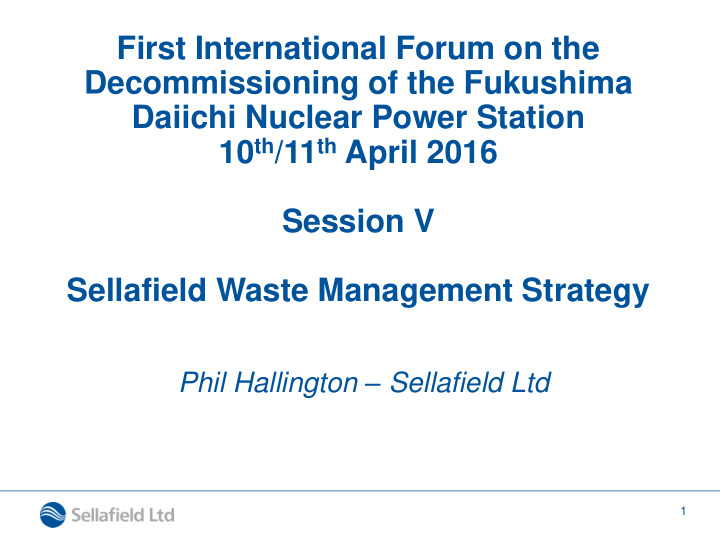



First International Forum on the Decommissioning of the Fukushima Daiichi Nuclear Power Station 10 th /11 th April 2016 Session V Sellafield Waste Management Strategy Phil Hallington – Sellafield Ltd 1
Background • 2 Square Miles • >200 nuclear facilities • Significant inventory • Supporting nuclear generation • Major national priority 2
Sellafield has more than 60 years of history… 1940s/50s 1960s/70s 1980s 1990s 2000s 2010s • • • • • • Nuclear build Waste stored Main expansion Commercialisation NDA formed Decision taken to safely – of reprocessing — begins of site end Thorp • pending Thorp comes Stop start progress reprocessing • • Initially a military treatment Major waste online in Decommissioning • programme treatment focus Vitrification of all • • • Storage Waste arising Calder Hall ceased overseas Highly • • Later civil capacity Environmental from processes generating power Active Waste treated in ‘real programme extended impact after 47 years in complete time’ begins incrementally substantially operation • reduced Decommissioning • • Coarse Product waste gathering pace segregation of forms compatible • waste arising with disposal First sludge exports from process concepts from FGMSP • Magnox reprocessing starts 3
Decommissioning Challenges • Material at risk • Large and uncertain inventories • Uncertain material conditions; original and current • Characterisation ranges from difficult to extremely challenging • Inadequate storage facilities • Uncertain design • Aging (~half-century or older) • Current condition and future service life unclear • Extended (decades) hazard removal terms • Complex and unprecedented tasks • Variable confidence in schedule 4
Recent successes – Pile Fuel Storage Pond Last skip of metal fuel Decanner removal removed Over 70% of the inventory safely retrieved in the past year 5
IWM Principles – links with Government policy Integrated Waste Management Objective: • To ensure that wastes are managed in a manner that protects people and the environment, now and in the future, and in ways that comply with government policies and provides value for money. 6
UK Waste Categories 7
Safety & Risk Reduction Avoid Managing Radioactive Waste Minimise Reduce Re-use Recycle Energy Recover Abate Dispose 8
Waste Management Strategy • Understand the arisings and therefore the options • Consider the impacts on • High hazard and risk reduction • Environment • ALARP/BAT • Costs • 10- 50 year look ahead • Geological Disposal Facility • 2040 for intermediate level waste • 2075 for high level waste • Legacy waste retrievals • We have continued to seek the best available approach • Spent fuel is not categorised as waste in the UK • Reprocessing waste handled in near real time • Potential for significant and targeted innovation • Challenge the paradigm • Technically rigorous solutions • Commanding broad support from Regulators and key stakeholders 9
Challenging the paradigm – an example Baseline plan Alternative ILW Approach 10
Innovative technologies 11
PP14 Data - Cumulative ILW Arisings to 2120 Prior to Rework Understanding and planning (excluding PCM) 100000 90000 80000 70000 60000 Packages 50000 40000 30000 20000 10000 0 Financial Year MBGWS AGR Graphite/St Steel AGR Graphite to Class 2 Package = 4 drum Operations (MEP/WEP/WPEP) LP&S (incl. SWR) High Order Decom & Windscale ILW stillage or 3m 3 box Low Order Decom & Windscale Piles Windscale (WAGR boxes) Decommissioning direct to GDF Current Decommissioning (no route) Contaminated Land Calder 12
Strategy enabling End State delivery GDF Available for GDF Available for ILW HLW/SF Broadfront SR&DP decommissioning Decommissioning DILWEP1 DILWEP2 FILWEP2 PFSP FGMSP Site Remediation BEP SPP1 P&E BUFT High hazard & MSSS risk reduction SDP PFCS PFCS TP THORP Broadfront Operations MAGNOX decommissioning Broadfront Operations decommissioning Calder SIXEP SWR WTC2 Others Includes Waste Treatment, Storage and Effluent Management BEPPS-DIF Stores 2013 2020 2030 2040 2050 2060 2070 2080 2090 2100 2110 2120 Lead time for Lead time for waste POCO route development planning 13
Risk Based Management Framework 14
Regulation at Sellafield • Robust, independent regulation – ENFORCEMENT • Collaborative working to deliver hazard and risk reduction – ENGAGEMENT & ENCOURAGEMENT • Demanding and effective Internal Regulatory function • Efficient delivery through “Engagement Week” model • Regulatory Interface Meeting • Transparency and Publication 15
What next? • Unrelenting focus on maintaining nuclear safety and security • Successful transition completed – now wholly owned NDA subsidiary • Driving fit for purpose solutions, such as - Pile Fuel Cladding Silo - Removal of ventilation stacks - Completion of Magnox reprocessing - Start-up of new HA Evaporator • Effective and Efficient spend of public money, delivering lasting value • Integrated waste strategy is key to effective delivery 16
Recommend
More recommend